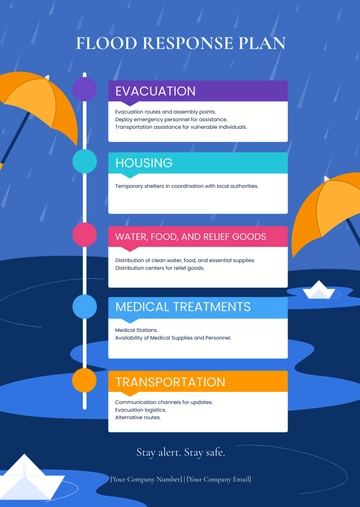Free Disaster Recovery Health and Safety Plan

Prepared by: [Your Name]
Company: [Your Company Name]
Date: [Insert Date]
1. Introduction
In the event of a disaster, it is crucial to have a well-defined plan in place to ensure the safety and health of all personnel involved. This Disaster Recovery Health and Safety Plan outlines the strategies and procedures to be followed to minimize risk and protect individuals during recovery operations.
2. Key Objectives
The primary objectives of this plan are:
Ensure the safety and health of all personnel.
Provide clear communication and instructions during recovery efforts.
Minimize risk of injury and exposure to hazards.
Facilitate efficient and effective recovery operations.
3. Risk Assessment and Management
3.1. Identifying Potential Hazards
A thorough risk assessment should be conducted to identify potential hazards associated with the recovery operations. These may include structural damage, electrical hazards, chemical exposure, and environmental factors.
3.2. Risk Mitigation Strategies
Implement measures to mitigate identified risks, including:
Ensuring proper personal protective equipment (PPE) is available and used.
Conducting safety briefings and training sessions.
Establishing safety zones and access controls.
Continuously monitoring conditions and adapting strategies as needed.
4. Roles and Responsibilities
Role | Responsibilities |
|---|---|
Incident Commander | Overall coordination of recovery operations, communication with emergency services, and decision-making. |
Safety Officer | Ensuring all safety protocols are followed and managing health and safety assessments on site. |
Operations Chief | Implementation of operational strategies and supervision of recovery activities. |
5. Communication Plan
5.1. Internal Communication
Establish clear lines of communication among the recovery team to ensure timely information sharing and coordination. Use radios, mobile phones, and other available technologies.
5.2. External Communication
Maintain open communication with external stakeholders, including emergency services, regulatory bodies, and the public, as needed.
6. Monitoring and Evaluation
Regularly monitor all aspects of the recovery operation to ensure compliance with safety standards and evaluate the effectiveness of the implemented strategies. Conduct debriefing sessions to capture lessons learned for continuous improvement.
7. Conclusion
Effective disaster recovery requires a comprehensive approach to health and safety. By adhering to this plan, organizations can protect personnel, reduce risks, and ensure a swift and successful recovery process. Continuous training and plan updates are essential for preparedness.
- 100% Customizable, free editor
- Access 1 Million+ Templates, photo’s & graphics
- Download or share as a template
- Click and replace photos, graphics, text, backgrounds
- Resize, crop, AI write & more
- Access advanced editor
You may also like
- Finance Plan
- Construction Plan
- Sales Plan
- Development Plan
- Career Plan
- Budget Plan
- HR Plan
- Education Plan
- Transition Plan
- Work Plan
- Training Plan
- Communication Plan
- Operation Plan
- Health And Safety Plan
- Strategy Plan
- Professional Development Plan
- Advertising Plan
- Risk Management Plan
- Restaurant Plan
- School Plan
- Nursing Home Patient Care Plan
- Nursing Care Plan
- Plan Event
- Startup Plan
- Social Media Plan
- Staffing Plan
- Annual Plan
- Content Plan
- Payment Plan
- Implementation Plan
- Hotel Plan
- Workout Plan
- Accounting Plan
- Campaign Plan
- Essay Plan
- 30 60 90 Day Plan
- Research Plan
- Recruitment Plan
- 90 Day Plan
- Quarterly Plan
- Emergency Plan
- 5 Year Plan
- Gym Plan
- Personal Plan
- IT and Software Plan
- Treatment Plan
- Real Estate Plan
- Law Firm Plan
- Healthcare Plan
- Improvement Plan
- Media Plan
- 5 Year Business Plan
- Learning Plan
- Marketing Campaign Plan
- Travel Agency Plan
- Cleaning Services Plan
- Interior Design Plan
- Performance Plan
- PR Plan
- Birth Plan
- Life Plan
- SEO Plan
- Disaster Recovery Plan
- Continuity Plan
- Launch Plan
- Legal Plan
- Behavior Plan
- Performance Improvement Plan
- Salon Plan
- Security Plan
- Security Management Plan
- Employee Development Plan
- Quality Plan
- Service Improvement Plan
- Growth Plan
- Incident Response Plan
- Basketball Plan
- Emergency Action Plan
- Product Launch Plan
- Spa Plan
- Employee Training Plan
- Data Analysis Plan
- Employee Action Plan
- Territory Plan
- Audit Plan
- Classroom Plan
- Activity Plan
- Parenting Plan
- Care Plan
- Project Execution Plan
- Exercise Plan
- Internship Plan
- Software Development Plan
- Continuous Improvement Plan
- Leave Plan
- 90 Day Sales Plan
- Advertising Agency Plan
- Employee Transition Plan
- Smart Action Plan
- Workplace Safety Plan
- Behavior Change Plan
- Contingency Plan
- Continuity of Operations Plan
- Health Plan
- Quality Control Plan
- Self Plan
- Sports Development Plan
- Change Management Plan
- Ecommerce Plan
- Personal Financial Plan
- Process Improvement Plan
- 30-60-90 Day Sales Plan
- Crisis Management Plan
- Engagement Plan
- Execution Plan
- Pandemic Plan
- Quality Assurance Plan
- Service Continuity Plan
- Agile Project Plan
- Fundraising Plan
- Job Transition Plan
- Asset Maintenance Plan
- Maintenance Plan
- Software Test Plan
- Staff Training and Development Plan
- 3 Year Plan
- Brand Activation Plan
- Release Plan
- Resource Plan
- Risk Mitigation Plan
- Teacher Plan
- 30 60 90 Day Plan for New Manager
- Food Safety Plan
- Food Truck Plan
- Hiring Plan
- Quality Management Plan
- Wellness Plan
- Behavior Intervention Plan
- Bonus Plan
- Investment Plan
- Maternity Leave Plan
- Pandemic Response Plan
- Succession Planning
- Coaching Plan
- Configuration Management Plan
- Remote Work Plan
- Self Care Plan
- Teaching Plan
- 100-Day Plan
- HACCP Plan
- Student Plan
- Sustainability Plan
- 30 60 90 Day Plan for Interview
- Access Plan
- Site Specific Safety Plan


























